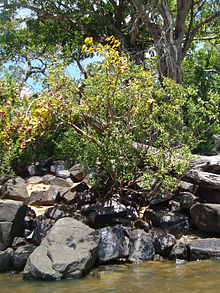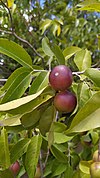Myrciaria dubia
| Myrciaria dubia | |
|---|---|

| |
| Scientific classification | |
| Kingdom: | Plantae |
| Clade: | Tracheophytes |
| Clade: | Angiosperms |
| Clade: | Eudicots |
| Clade: | Rosids |
| Order: | Myrtales |
| Family: | Myrtaceae |
| Genus: | Myrciaria |
| Species: | M. dubia
|
| Binomial name | |
| Myrciaria dubia (Kunth) McVaugh
| |
| Synonyms[2] | |
| |

Myrciaria dubia, commonly known as camu-camu, caçari, araçá-d'água, or camocamo, is a species of plant in the family Myrtaceae. It is a small bushy riverside tree from the Amazon rainforest in Peru and Brazil, which grows to a height of 3–5 m (9.8–16.4 ft) and bears a red/purple cherry-like fruit. It is a close relative of the false jaboticaba (Myrciaria vexator) and the guavaberry or rumberry (Myrciaria floribunda). As much as 2 to 3% of the fresh fruit by weight is vitamin C.
Description
[edit]Camu-camu has small flowers with waxy white petals and a sweet-smelling aroma. It has bushy, feathery foliage. The evergreen, opposite leaves are lanceolate to elliptic. Individual leaves are 3–20 cm (1.2–7.9 in) in length and 1–2 cm (0.39–0.79 in) wide.[citation needed]
The camu-camu fruit is maroon or purple-black when fully ripe, around 25 mm in diameter, with either sweet or acidic flesh.[3]
Native range
[edit]The current range of camu-camu consists of the Amazonian lowlands of Colombia, Ecuador, Peru, Bolivia, and Brazil. Its distribution extends from the center of Pará state, Brazil, along the mid and upper Amazon River to the eastern part of Peru; in the north, it appears in the Casiquiare canal and the upper and middle Orinoco River. In Brazil, it is found in Rondônia along the Maçangana and Urupá Rivers and in Amazonas, in the municipalities of Manaus and Manacapuru and along the Javari, Madeira, and Negro Rivers.[citation needed]
Harvest
[edit]This section needs additional citations for verification. (January 2021) |
Long used by native peoples, wild camu-camu fruit is harvested directly into canoes. The fruit has only recently come into large-scale cultivation and sale to the world market, with Japan being the major buyer. The tree is relatively easy to cultivate within certain growing conditions. It survives best in hot, damp, tropical climates, but will grow in the subtropics, surviving temperatures down to just above freezing. It requires copious water. Fair trade is present in low-land production from the Association of Camu Camu Producers of the Peruvian Amazon.
The tree occurs in locally dense populations or even monospecific stands in Amazonian flood plains and riparian vegetation. The plant is extremely tolerant of flooding, withstanding four to five months with the roots and even much of the aerial parts submerged in water.[4] The species propagates through seeds. In cultivation, the tree begins bearing fruits after attaining 2 cm (0.79 in) in stem girth (three years after emergence of the seedling). Plants flower at the end of the dry season and produce fruit at the peak of the rainy season. Observations with both wild and cultivated plants suggest that the trees can remain productive for several decades.
Wild trees have been found to yield 12 kg (26 lb) of fruit on average. At suggested planting densities of 600–1100 trees per 1 ha (2.5 acres), about 12 t (12 long tons; 13 short tons) fruit may be derived in cultivation from one hectare.
Nutrition
[edit]Per 100 g of fresh fruit:
- Protein 0.4 g
- Carbohydrates 5.9 g
- Starches 0.44 g
- Sugars 1.28 g
- Dietary Fiber 1.1 g
- Fat 0.2 g
- Calcium 15.7 mg
- Copper 0.2 mg
- Iron 0.53 mg
- Magnesium 12.4 mg
- Manganese 2.1 mg
- Potassium 83.9 mg
- Sodium 11.1 mg
- Zinc 0.2 mg
- Vitamin C: ranges from 1882–2280 mg depending on ripeness.[5]
Camu-camu has an extraordinarily high vitamin C content (on the order of 2–3% of fresh weight).[6][7] Vitamin C content declines as full maturity is reached, with a trade-off between vitamin C and flavor expression.[8]
The fruit is rich in flavonoids, such as anthocyanins, flavonols, flavanols, catechins, delphinidin 3-glucoside, cyanidin 3-glucoside, ellagic acid, and rutin. Other analysis revealed the presence of gallic and ellagic acids, suggesting that the fruit possesses hydrolyzed tannins (gallotannin and ellagitannins).[9]
Uses
[edit]
Documentation of traditional camu-camu uses is scarce. In traditional Amazonian societies, camu-camu is not likely to have ever been nutritionally relevant except for its vitamin C content. The fruit is extremely acidic and the flavor much like a sour grape with a large pit. The fruit is often used to make a very pink juice with a little sugar (like lemonade). A reddish pigment in the leathery skin of the fruit imparts a pink color on juices extracted from camu-camu. The aroma is subtle, but is not so captivating as in more popular fruits. Recently, camu-camu is used in ice creams and sweets and processed powder from the fruit pulp is beginning to be sold in the west as a health food in loose powder or capsule form.[citation needed]
Native Amazonian groups living on the banks of the Nanay River in the Loreto region of Peru, have been reported as using camu-camu as a traditional remedy for the treatment of malaria.[10]
Conservation issues
[edit]Overharvesting of wild camu-camu threatens to make it an endangered species. Efforts are underway to encourage commercial growing of camu-camu in the Amazon River basin.[11][12]
References
[edit]- ^ IUCN SSC Global Tree Specialist Group, Botanic Gardens Conservation International (BGCI); Canteiro, C. (2019). "Myrciaria dubia". IUCN Red List of Threatened Species. 2019: e.T152941355A152941357. doi:10.2305/IUCN.UK.2019-3.RLTS.T152941355A152941357.en. Retrieved 12 December 2022.
- ^ "Myrciaria dubia (Kunth) McVaugh". The Plant List: A Working List of All Plant Species. Retrieved 16 January 2021.
- ^ "Myrciaria dubia". Useful Tropical Plants. Retrieved 16 January 2021.
- ^ Rodrigues, Sueli; Silva, Ebenezer; de Brito, Edy, eds. (6 January 2018). Exotic Fruits Reference Guide. Academic Press. pp. 97–105. ISBN 9780128031384.
- ^ Mst. Sorifa Aktera; Sejong Ohb; Jong-Bang Euna; Maruf Ahmed (August 2011). "Nutritional compositions and health promoting phytochemicals of camu-camu (Myrciaria dubia) fruit: A review". Food Research International. 44 (7): 1728–32. doi:10.1016/j.foodres.2011.03.045.
- ^ Peruvian Camu Camu fruit conquers Japan Archived 27 September 2013 at the Wayback Machine Percy Takayama, Living in Peru - Business, 12 February 2007. Accessed July 2012.
- ^ "Artigo - Camu-camu: fruto amazônico com mais vitamina C que o limão!" (in Portuguese). 20 October 2009.
- ^ Justi, K C; Visentainer, J V; Evelázio de Souza, N; Matsushita, M (2000). "Nutritional composition and vitamin C stability in stored camu-camu (Myrciaria dubia) pulp". Arch Latinoam Nutr. 50 (4): 405–8. PMID 11464674.
- ^ Chirinos, Rosana; Galarza, Jorge; Betalleluz-Pallardel, Indira; Pedreschi, Romina; Campos, David (2010). "Antioxidant compounds and antioxidant capacity of Peruvian camu camu (Myrciaria dubia (H.B.K.) McVaugh) fruit at different maturity stages". Food Chemistry. 120 (4): 1019–1024. doi:10.1016/j.foodchem.2009.11.041. ISSN 0308-8146.
- ^ Ruiz, Lastenia; Ruiz, Liliana; Maco, M; Cobos, M; Gutierrez-Choquevilca, AL; Roumy, V (2011). "Plants used by native Amazonian groups from the Nanay River (Peru) for the treatment of malaria". J Ethnopharmacol. 133 (2): 917–21. doi:10.1016/j.jep.2010.10.039. PMID 21040768.
- ^ Conservation issues Archived 12 March 2012 at the Wayback Machine with pictures of the tree, fruits and harvest method.
- ^ Martin, Meredith; Peters, C. M.; Ashton, Mark S. (2014). "Revisiting Camu-camu (Myrciaria dubia): Twenty-seven Years of Fruit Collection and Flooding at an Oxbow Lake Peruvian Amazonia 1". Economic Botany. 68 (2): 169–176. doi:10.1007/s12231-014-9269-4.
External links
[edit]- Conservation issues with pictures of the tree, fruits, and harvest method.
- Myrciaria dubia List of Chemicals (Dr. Duke's Database)

